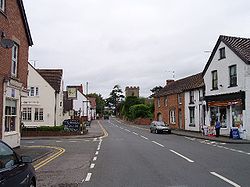| Eckington | |
|---|---|
 | |
Location within Worcestershire | |
| Population | 1,202 |
| OS grid reference | SO9241 |
| District | |
| Shire county | |
| Region | |
| Country | England |
| Sovereign state | United Kingdom |
| Post town | Pershore |
| Postcode district | WR10 |
| UK Parliament | |
Eckington is a small village near to the southern border of the English county of Worcestershire, according to the 2001 census it had a population of 1,202.
Contents
The River Avon passes the village to the North and West and these areas are prone to flooding. It is situated at the north-west side of Bredon Hill, an outcrop of the Cotswolds. The nearest towns to Eckington and also situated along the River Avon are Pershore which is 4 miles (6 km) north and Evesham 10 miles (16 km) north east. The historic town of Tewkesbury is situated 8 miles (13 km) south west on the River Severn which river also runs through the nearest city of Worcester (13 miles (21 km) from Eckington).
Eckington is renowned for Eckington Bridge, which is the subject of a poem by Arthur Quiller-Couch, [1] its village cross and its Norman-period church. It has a school, the Eckington Church of England First School, a recreation centre and scout hut with surrounding recreation grounds, home to the village's football and cricket teams, and a village hall. In 2023, Community Fields were opened, with paths for walking, grassed and wild flower areas, and plans for a memorial garden near to the cemetery.
Eckington has a village shop and two hairdressers. It currently has two pubs The Bell and The Anchor, both offering food and guest accommodation; a third pub, The Crown, closed in the early 1990s.
Eckington railway station was located on the Bristol to Birmingham Line main railway line. It closed in January 1965.
One of the Pilgrim Fathers, George Soule, is believed to have come from the village. [2] [3]
